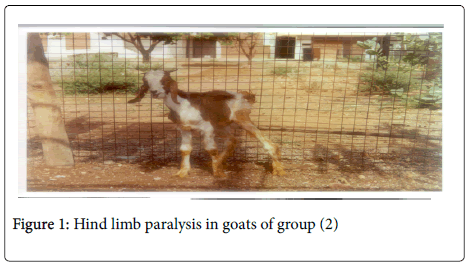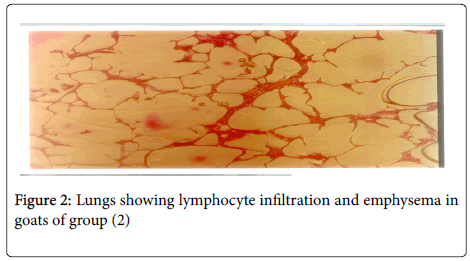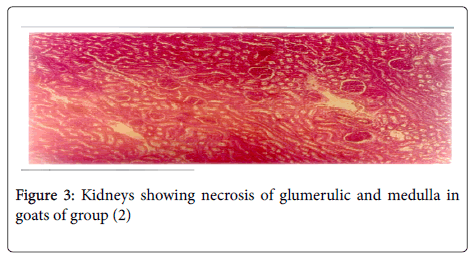Research Article Open Access
Toxicity Effects of Both Alum and Poly-DADMAC on Nubian Goats Evita
Amna Ahmed1, Samia Elbadwi2 and Ahmed Mohammed2*
1University of Medical Sciences & Technology, Faculty of Pharmacy, Khartoum, 12810 Sudan
2University of Khartoum, Department of Pharmacology & Toxicology, Khartoum, Sudan
- *Corresponding Author:
- Amna Ahmed
University of Medical Sciences & Technology
Faculty of Pharmacy, Khartoum, 12810 Sudan
Tel: +249912369706
Fax: +249183224799
E-mail: amna_medani@yahoo.com
Received date: Augest 12, 2015 Accepted date: September 29, 2015 Published date: October 01, 2015
Citation: Ahmed A, Elbadwi S, Mohammed A (2015) Toxicity Effects of Both Alum and Poly-DADMAC on Nubian Goats Evita . Toxicol Open Access 1:101. doi:10.4172/2476-2067.1000101
Copyright: © 2015 Ahmed A et al. This is an open-access article distributed under the terms of the Creative Commons Attribution License, which permits unrestricted use, distribution, and reproduction in any medium, provided the original author and source are credited.
Visit for more related articles at Toxicology: Open Access
Abstract
Nubian goats were the animals tested for the toxicity of both alum and polydadmac blend of 1% alum and 1% polydadmac at 1:2 Clinical signs of tested goats showed interrupted salivation, vomiting, watery diarrhea, dullness, inappetance ,inability to move accompanied by hind limb paralysis and finally recumbency. On postmortem, and histopathological assessment, most vital organs were clearly affected. Serum concentrations of tested enzymes showed marked (P0<0.05-0.01) fluctuations in the test group of goats. The test group showed marked (P<0.01-0.001differences when evaluating their serum levels of metablites. Goats of test group 2 showed significant (P<0.05-0.01) changes when tested for serum levels of electrolytes. All serum values detected, showed normal values in the control goats.On evaluation of results, the water treatment with 1% alum and 1% polydadmac at 1:2 was considered toxic to Nubian goats.
Keywords
Alum; Drinking water; Nubian goats; Poly-DADMAC; Toxicity
Introduction
In the Sudan, the first use of a chemical to reduce the turbidity of the Nile water especially during the flood season to be suitable for the healthy human consumption. The disposal system to eliminate the outcome of the sludge of the chemical reactions that happen during treatment of the turbid water is not adjusted well to the laws of environmental health regulations. Throughout the time Alum did not give satisfactory results in the reduction of turbidity of water, so new methodologies were introduced with special preference in use of polydadmac polymer. Toxicological data were always lacking and hence subjected this use to a lot of debate. This experiment is a trial to lead the way out.
Materials
Animals
Six, 5-7 month old mixed, clinically healthy Nubian goats were purchased from Balsam Pharmaceutical Laboratories in the vicinity of Khartoum North, housed and were given prophylactic doses of oxytetracycline 20%. The goats were ear tagged, given a two-week preliminary period during which Lucerne was fed and Nile drinking water was provided ad libitum
Administration of the doses
Test materials of poly-DADMAC and alum (AlSO4 ) were prepared in separate stocks each as a 1% solution of each. The two test solutions were blended at the dose rate of 1:2 of the polymer and alum respectively. Animals were weighed and distributed into two experimental groups. Test blend was given orally to goats of group 2 in drinking water obtained from the Nile daily. The untreated controls were the goats of group 1.
Methods
Clinical signs
These were observed and post-mortem changes were recorded.
Histological methods
The specimens were collected immediately after death or slaughter and fixed in 10% formal saline, embedded in paraffin wax, sectioned at 5 μm and stained with haematoxylin and eosin (H&E) using Mayer's haemalum.
Haematological methods
These were described by Schalm, 1965 [1]. Blood samples from goats were collected into clean dry bottles containing the anticoagulant heparin from the ear vein. Hb concentrations together with counts of RBCs, WBCs and PCV were then investigated.
Chemical methods
Blood samples obtained the ear vein of goats before and after dosing with the joint solution. Venous blood samples were centrifuged at 3000 r.p.m. for 5 minutes and stored at -20°C until analysed for enzymatic activities of ALP,GOT, ,CK ,GPT and LDH ; The metabolic changes in response to treatment in albumin, urea, total protein, cholesterol, bilirubin, glucose and creatinine and finally the changes in the electrolytes magnesium, iron, sodium, potassium, calcium and phosphorus .
Statistical methods
The difference between mean values of data was analyzed by the unpaired students- t-test (Snedecor and Cochran, 1989) [2].
Results
Clinical signs and mortality rates
The goat kids of this (group 2) showed interrupted salivation, vomiting, watery diarrhoea, dullness, inappitance, they were unable to stand or move slowly (Figure 1) and finally they became recumbent. Their mortality rate was about 33.3%. No odd signs were observed in the control (group 1) of goats.
Postmorteum changes
Intestinal and stomach bloats were obvious, heart were flabby, congested and enlarged, liver were congested, necrotic, and haemorrhagic and the kidney were necrotic and haemorrhagic. A clearly normal scene was obvious in the undosed control (group 1) of goat-kids.
Histopathological picture
The livers suffered from generalized necrosis and congestion, lungs showed lymphocyte infiltration and emphysema (Figure 2), intestines showed congestion; necrosis of muscular is mucose and the kidneys showed necrosis of glumerulic and necrosis of the medulla (Figure 3). Abnormalities were not observed in (group 1) goats (undosed controls).
Serum enzymes changes
| Group No | ALP | GOT | CK | GPT | LDH |
|---|---|---|---|---|---|
| G1 | 151.58 ± 1.05 | 33.81 ± 4.43 | 1.90 ± 0.26 | 18.37 ± 1.62 | 40.80±0.35 |
| G2 | 107.58 ± 1.05 | 77.91±3.71 | 4.77±0.49 | 45.67±2.25 | 62.26±1.64 |
Table 1: Average values (mean ± SD) of serum enzymes of the combined 1% alum and 1% polymer-dosed goats.
Serum concentrations of CK, GOT, GPT and LDH showed marked (P0<0.05-0.01) increases in both test groups of goats compared to the control. Remarkable (P<0.05) decreases were observed in both test groups when testing their serum values of ALP. The serum enzymatic levels of the control group were demonstrating normal values.
Serum metabolites changes
| Group No | Bilirubin | Glucose | Creatinine | Cholesterol |
|---|---|---|---|---|
| G1 | 0.18 ± 1.25 | 31.08 ± 0.87 | 0.21 ± 0.04 | 38.10 ± 3.59 |
| G2 | 0.18 ± 2.25 NS | 24.67 ± 0.34 | 0.74 ± 0.00 | 40.88 ± 8.46 NS |
| Group No | Albumin | Uric acid | Urea | Total protein |
| G1 | 3.01 ± 0.37 | 0.92 ± 0.13 | 35.35 ± 4.37 | 5.47 ± 0.75 |
| G2 | 3.16 ± 0.36 NS | 0.84 ± 0.00 NS | 68.79 ± 1.62 | 5.22 ± 0.06 NS |
Table 2: Average values(mean ± SD) of serum metabolites of the combined 1% alum and 1% polymer-dosed goats.
The test group showed marked (P<0.01-0.001) increases when evaluating their serum levels of urea and creatinine, whereas they were recording insignificant (P>0.05) treatment effect for their serum levels of albumin ,uric acid, total protein, bilirubin and cholesterol in comparison to their level in the control group. Glucose values were lower in group 2 (P<0.001) and 15 (P>0.05) than the control group which showed always normal ranges of all of the metabolites evaluated above.
Serum electrolytes values
Goats of test group 2 showed significant (P<0.05-0.01) changes when tested for serum levels of magnesium, sodium, and potassium.The readings for electrolytes levels in the serum of the control goats were normal.
| Group No | Mg | Iron | Na | K | Ca | P |
|---|---|---|---|---|---|---|
| G1 | 1.44 ± 0.08 | 228.77 ± 13.73 | 152.53 ± 0.42 | 5.69 ± 0.12 | 6.92 ± 1.44 | 5.14 ± 1.11 |
| G2 | 0.98 ± 0.04** | 213.93 ± 7.51 NS | 150.73 ± 0.23** | 6.70 ± 0.02** | 5.24 ± 0.04 NS | 5.00 ± 0.00 NS |
Table 3: Average values (mean ± SD) of serum electrolytes of the combined 1% alum and 1% polymer-dosed goats.
Suggestive Conclusion
Considerable rates of mortality observed in group 2 goats may be due to myocardial and nervous system (CNS) involvement (mostly the parasympathetic) may be due to choline-esterase inhibition especially on the hind limb [3]. This was accompanied by a generalized fall in serum electrolytes which may be due to nausea, vomiting and diarrhea, the thing which lead to an advanced state (accompanied with the increased concentration of GOT, decreased Mg and Na and increase in K) of myopathy shown in incoordinated posture and movement. Pulmonary hemorrhages, edema, emphysema, necrosis and adhesions lead to the clinically observed difficulty in respiration which was constituting the irritant affections of the substances and/or their metabolites. Hepatic damage was expressed in the congested and necrotic central view, increased serum enzymatic concentrations of CK, GOT, GPT and LDH and the decrease in ALP [4-6]. The irritant substance or is metabolites lead to focal enteritis seen in nausea, salivation and the vomiting and watery diarrhea and necrosis of muscular is mucosa which may also be due to increase peristaltic movement due to choline -esterase inhibition or both. Hypocalcaemia is similar to that described by Ali and Adam [7], Galal and Adam [8], El Dirdiri et al. [9] and Mohamed and Adam [10].
In young ruminants lymphocyte infiltration probably suggests the development of suppression in the immune system of the poisoned goats [11]. The haemorrhage and necrotic kidneys which was accompanied by the increased creatinine concentrations are indicating renal insufficiency if we considered the additive effect of urea concentrations in serum indicating damage to renal tubules [12]. The available results and the studies of Mohamed and Adam [13-15] suggested that serum urea level is of significance in the evaluation of renal toxicity in goats. All the above elaborate screening of alum and polyDADMAC revealed that both are toxic to Nubian goats.
References
- Schalm OW (1965) Minutes of The Regents of the University of California.
- Snedecor GW and Cochran WG (1989) Statistical Methods (8th edn.) Iowa State University Press, USA.
- EXTOXNET (Extension Toxicology Network) (1993) Toxicology Information Briefs. Oregon State University.
- Ford EJH, Adam SEI, Gopinath C (1972) Hepatic amidopyrine N-demethylase activity in the calf. Journal of Comparative Pathology, 82: 355.
- Adam SEI (1972) A review of drug hepatotoxicity in animals. Veterinary Bulletin 42: 583.
- Adam SEI, Tartour G, Obeid HM, Idris OF (1973 ) Effects Ipomeacarnea on the liver and serum enzymes in young ruminants. Journal of comper Path 83: 351.
- Ali B, Adam SEI (1978) Effects of A canthospermumhispidum on goats. Journal of Comparative Pathology 88: 533.
- Galal M, Adam SEI (1988) Experimental Chrozophora plicate poisoning in goats and sheep.Veterinary and Human Toxicology 30: 447.
- El Dirdiri NI, Barakat SEM, Adam SEI (1987) The combined toxicity of Aristolochiabracteata and Cadabarotundifolia to goats.Veterinary and Human Toxicology 29: 133.
- Mohamed OSA, Adam SEI (1992) Effect of phenobarbitone pretreatment on the toxicity of temik and sumicidin in Nubian goats.Veterinary and Human Toxicology 34: 138.
- Rosenberg HF, Gallin JI, Paul WE (1999) Inflammation. In: Paul WE (ed.) Fundamental immunology. Lippincott-Raven,Philadelphia,p.1051.
- Halfman CJ (2000) Laboratory Evaluation of Renal Function. Laboratory Medicine and Patho Physiology..
- Mohamed OSA, Adam SEI (1990) Toxicity of sumicidin (Fenvalerate) to Nubian goats. Journal of comparative pathology 102: 1.
- Mohamed OSA, Adam SEI (1992) Effect of phenobarbitone pretreatment on the toxicity of temik and sumicidin in Nubian goats.Veterinary and Human Toxicology 34: 138.
- Ahmed OMM, Adam SEI (1979) Effect of Jatrophacureasoncalves. Veterinary pathology 16: 476.
Relevant Topics
- Aflatoxins
- Cardiac Toxicity
- Chemical Toxicology
- Developmental Toxicology
- Drug Toxicity
- Heavy Metal Toxicity
- Heavy Metal Toxins
- Industrial Hygiene Toxicology
- Insecticides Toxicology
- Metal Toxicology
- Nano Toxicology
- Pesticidal Toxicology
- Renal Toxicity
- Reproductive Toxicology
- Skin Toxicology
- Tetanus Toxin
- Toxicogenomics
- Toxicology Reports
- Toxicology Testing
Recommended Journals
Article Tools
Article Usage
- Total views: 10556
- [From(publication date):
December-2015 - Apr 02, 2025] - Breakdown by view type
- HTML page views : 9709
- PDF downloads : 847



